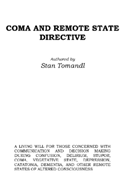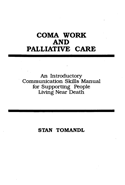
Coma Work Theory: Awakening to Inner Work
FOR INFORMATION ON PHONE CONSULTATIONS AND CLASSES;
AND REMOTE VIDEO (SKYPE) BEDSIDE COMA COMMUNICATION AND CARE;
CONTACT STAN TOMANDL AND ANN JACOB; 250-383-5677 (CANADA)
* * *
Coma Work Videos
Coma Work Interview with Dr. Arnold Mindell – Part 1
Coma Work Interview with Dr. Arnold Mindell – Part 2
Coma Work Interview with Dr. Arnold Mindell – Part 3
Coma Work Theory: Awakening to Inner Work
Even though comatose patients may be dramatically impaired, process oriented coma workers believe coma can call people to deep inner work. Remote states of consciousness, including coma, can present situations: for exploring the meaning of life; for completing unfinished business; for making spiritual connections; and for facilitating major life changes.
Some part of the comatose patient is present within his or her remote state even though perhaps severely damaged. Communication can be established by using alternative interventions. Comatose patients do their best under the circumstances they find themselves in, though they may have little or no awareness of what is transpiring in their inner and outer worlds.
The coma worker acts like an awareness assistant, helping bring inner and outer events to greater consciousness. This aids those in remote states to process information and make decisions based on their experience. As coma workers we trust sensory-grounded communication signals, and interact according to positive and negative feedback from patients. If those in coma are able to complete their inner work, they will spontaneously emerge into more ordinary states of consciousness, as far as their condition will allow.
Ethics, benefits, feedback, disclaimer and release
When working with those in coma, we follow these precautions: We introduce ourselves to the patient; ask permission to communicate; pay attention to feedback; and work within the bounds of the medical system and family culture.
Coma work does not supersede medical care. Coma work is not a “cure.” Coma workers facilitate communication within the patient, and with those in the surrounding environment. Coma work can be long, difficult and time consuming.
The work includes videotaping patient’s communication patterns from time to time for consultation with fellow professionals and study by family members. Permission and release for video taping of patient and participants is strongly recommended.
The benefits of coma work to the family include taking an active role in the communication, care and rehabilitation of the patient, should they be willing and able to do so. Coma work training for the family emphasizes the following:
People in coma states are extremely sensitive and extremely powerful. If they don’t like what is going on they can stay inside or go further away. By being aware, you can learn when you are staying in or out of direct contact with them.
You need patience, courage, awareness and caring to communicate with someone in a remote altered state. Trust your intuitions and your body feelings. Be willing to experiment with interventions but respect your personal comfort limits. If you feel uncomfortable or tired then you can assume that the patient probably feels the same. Be persistent with your communication attempts and be sensitive to feedback from the patient and yourself.
The underlying idea is to follow the patients’ processes in an attempt to help them get “unstuck” from their remote inner states. The patient is “in charge”, so the outcome is varied and potentially creative.
Coma Work skills, interventions, and attitudes
Process work skills and interventions used in coma work include: minimal signals; pacing the breath; “cheerleading”; feedback; amplification; blank access; following; binary communication; and symbolic language. Each of these is defined below:
1. Minimal Signals: These are small bits of information: for example, the blink of an eyelid, twitch of the nose, and tapping of a finger. Minimal signals indicate possible starting points for interactions that may lead to important processes.
2. Pacing the Breath: Pacing is a skill that can be taught quickly and easily. It involves hands-on contact to communicate through body sensations with the comatose person. (For detailed instructions and exercises see Coma Work and Palliative Care by Stan Tomandl, 1991: 44-5)
3. Cheerleading: Cheerleading means encouraging everything, using the uplifting tone of a loving parent giving acceptance, approval and encouragement to a child.
4. Feedback: A response to a stimulus or interaction. An exchange of information. Feedback may be positive, negative (no response) or mixed. Coma work operates on moment-to-moment feedback.
5. Amplification: This means enlarging, exaggerating and focusing on signals to make them more powerful. Amplified signals communicate their messages faster and easier. For example, when amplified, a patient’s small upward finger movement grew into reaching for the heavens.
6. Blank Access: These are statements or interactions without content. They support the person’s process without projecting into it. This open-ended technique allows the patient to “fill in the blanks” with his or her own material. For example: “Go ahead and feel what you’re feeling.”
7. Following: Following involves observing multiple communication channels simultaneously, then encouraging the various communication signals as they move within and between channels. Following literally means following based on feedback, rather than leading the process.
8. Binary Communication: This involves identifying a communication channel and signal that the comatose person repeats, then using this information to establish contact. An example would be, “If you are in pain, move any part of your body.” This frees the comatose patient from having to conform to preconceived expectations for verbal communication.
9. Symbolic Language: For patients with some verbal functioning, this means searching beyond the literal meaning of words and sounds. To understand symbolic language requires being a detective, discovering the clues and implications, then interpreting them within the context of personal, family, and community history.
And Coma Work is more than the sum of these skills. Coma Work offers awareness and access to the sacred inner life.
* * *
Nine Near Death and Coma Work Tips for Helpers and Family
* * *
Example: Recovery from Stroke and Metabolic coma
* * *
Example: Coma Work ~ One Family’s Experience with Structural Coma
* * *
Coma Work and Paliative Care ~ Communication Skills Manual
* * *
Consciousness in “Coma” goes unseen by Medical Professionals
- The following article about “Doctors missing consciousenss…” seems crucial to the potential for consciousness in coma. So we reproduced the entire article; thanks to “New Scientist”
FOR INFORMATION ON PHONE CONSULTATIONS AND CLASSES;
AND REMOTE VIDEO (SKYPE) BEDSIDE COMA COMMUNICATION AND CARE;
CONTACT STAN TOMANDL AND ANN JACOB; 250-383-5677 (CANADA)



